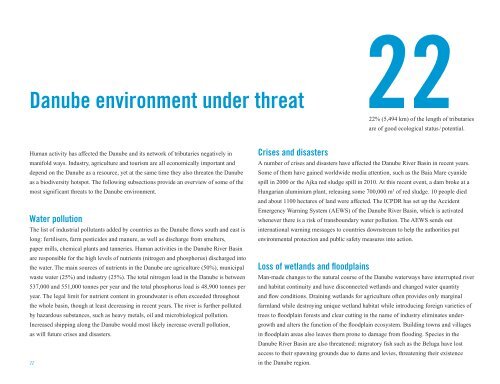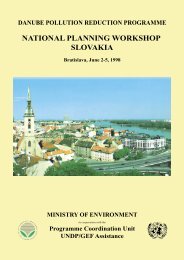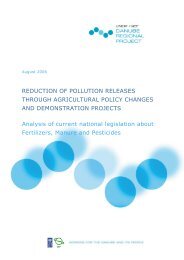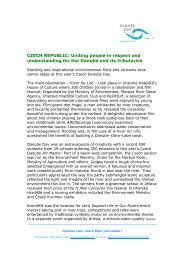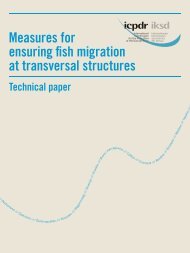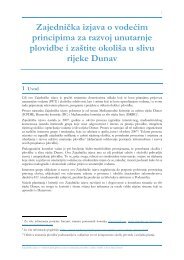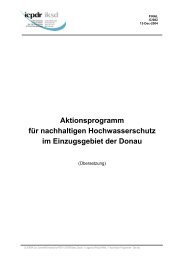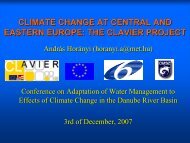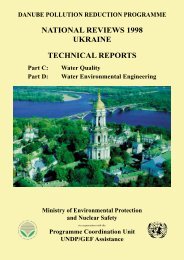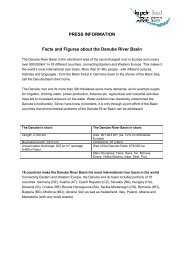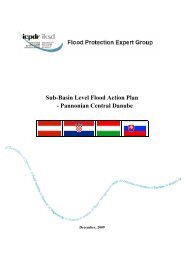Create successful ePaper yourself
Turn your PDF publications into a flip-book with our unique Google optimized e-Paper software.
Danube environment under threat<br />
22<br />
22% (5,494 km) of the length of tributaries<br />
are of good ecological status / potential.<br />
Human activity has affected the Danube and its network of tributaries negatively in<br />
manifold ways. Industry, agriculture and tourism are all economically important and<br />
depend on the Danube as a resource, yet at the same time they also threaten the Danube<br />
as a biodiversity hotspot. The following subsections provide an overview of some of the<br />
most significant threats to the Danube environment.<br />
Water pollution<br />
The list of industrial pollutants added by countries as the Danube flows south and east is<br />
long: fertilisers, farm pesticides and manure, as well as discharge from smelters,<br />
paper mills, chemical plants and tanneries. Human activities in the Danube River Basin<br />
are responsible for the high levels of nutrients (nitrogen and phosphorus) discharged into<br />
the water. The main sources of nutrients in the Danube are agriculture (50%), municipal<br />
waste water (25%) and industry (25%). The total nitrogen load in the Danube is between<br />
537,000 and 551,000 tonnes per year and the total phosphorus load is 48,900 tonnes per<br />
year. The legal limit for nutrient content in groundwater is often exceeded throughout<br />
the whole basin, though at least decreasing in recent years. The river is further polluted<br />
by hazar dous substances, such as heavy metals, oil and microbiological pollution.<br />
Increased shipping along the Danube would most likely increase overall pollution,<br />
as will future crises and disasters.<br />
22<br />
Crises and disasters<br />
A number of crises and disasters have affected the Danube River Basin in recent years.<br />
Some of them have gained worldwide media attention, such as the Baia Mare cyanide<br />
spill in 2000 or the Ajka red sludge spill in 2010. At this recent event, a dam broke at a<br />
Hungarian aluminium plant, releasing some 700,000 m 3 of red sludge. 10 people died<br />
and about 1100 hectares of land were affected. The <strong>ICPDR</strong> has set up the Accident<br />
Emergency Warning System (AEWS) of the Danube River Basin, which is activated<br />
whenever there is a risk of transboundary water pollution. The AEWS sends out<br />
international warning messages to countries downstream to help the authorities put<br />
environmental protection and public safety measures into action.<br />
Loss of wetlands and floodplains<br />
Man-made changes to the natural course of the Danube waterways have interrupted river<br />
and habitat continuity and have disconnected wetlands and changed water quantity<br />
and flow conditions. Draining wetlands for agriculture often provides only marginal<br />
farmland while destroying unique wetland habitat while introducing foreign varieties of<br />
trees to floodplain forests and clear cutting in the name of industry eliminates undergrowth<br />
and alters the function of the floodplain ecosystem. Building towns and villages<br />
in floodplain areas also leaves them prone to damage from flooding. Species in the<br />
Danube River Basin are also threatened: migratory fish such as the Beluga have lost<br />
access to their spawning grounds due to dams and levies, threatening their existence<br />
in the Danube region.


